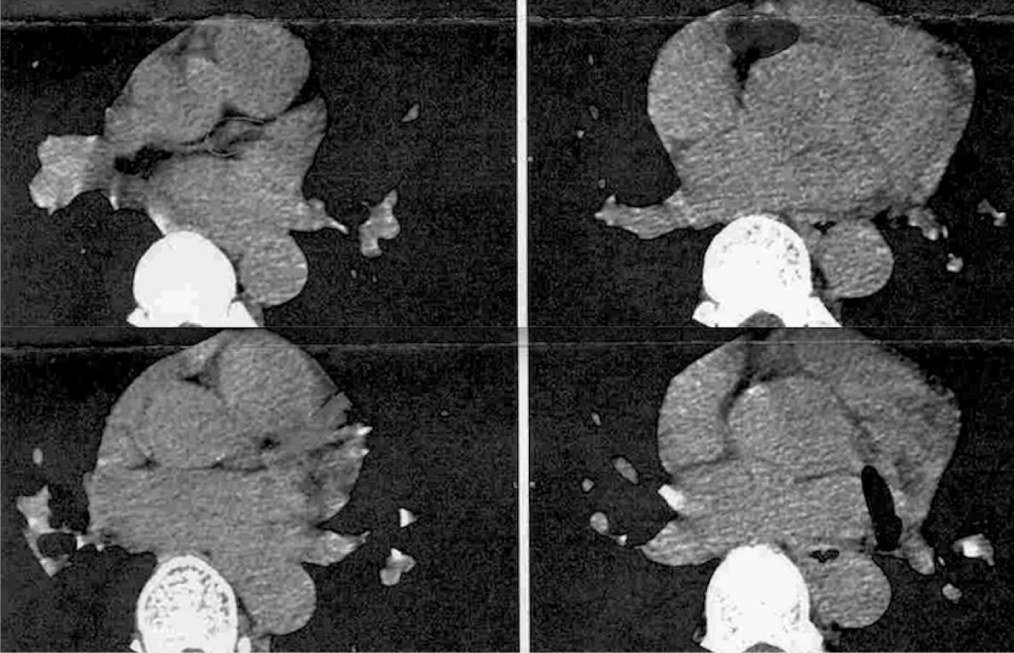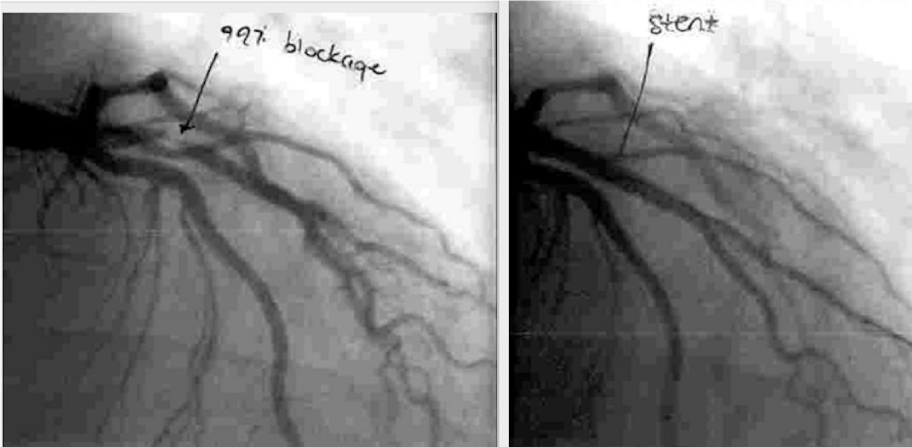Journal of Cardiovascular Medicine and Cardiology
Coronary Artery Calcium (CAC) Scoring and Treatment Decision Making
Richard M Fleming1*, Matthew R Fleming1 and Tapan K Chaudhuri2
2MD, Eastern Virginia Medical School, Norfolk, Virginia, USA
Cite this as
Fleming RM, Fleming MR, Chaudhuri TK (2019) Coronary Artery Calcium (CAC) Scoring and Treatment Decision Making. J Cardiovasc Med Cardiol 6(4): 092-093. DOI: 10.17352/2455-2976.000100A variety of methods are currently employed qualitatively looking for the presence or absence of Coronary Artery Disease (CAD). These tests are limited by that, which they are looking for. In the instance of Coronary Artery Calcium (CAC) scoring, CAC scores are looking for the presence or absence of calcium. Not all atherosclerotic CAD has sclerotic lesions. Consequently, a zero or low CAC value does not exclude CAD. This paper represents the importance of clinical decision making when CAC scoring fails to find CAD.
Introduction
One of the first lessons you are taught during clinical rotations in medical school is that a negative test doesn’t necessarily help you. It either means what you are looking for isn’t there, or the test missed it. The underlying message is that a test, which has acceptable sensitivity–positive if there is a problem–may have less than desirable specificity (exclusion of the problem), when the test result returns negative. Thus, if the test doesn’t find the problem, you and the patient are left with the question of what to do next.
A currently promulgated anatomic test for Coronary Artery Disease (CAD) is the Coronary Artery Calcium (CAC) Computed Tomography (CT) test, based upon the presumption that all CAD eventually demonstrates calcium deposition [1-5]. The CAC test, which is scored based upon the detection of calcium - using essentially the same approach as the bone density exam (aka DEXA) – is derived from a semi-quantitative value called the Agatston score.
The Agatston score is a weighted value of 1, 2, 3 or 4 (Table 1) based upon the radio density of the tissue measured in Hounsfield units (Hu). This weighted value is then multiplied by the area (mm2) based upon the limits of the CT device used to derive the Agatston score.
One proposed use of the CAC score is its inclusion into a battery of tests already being used for treatment decision-making [6,7]. We present a clinical example of one such patient seeking further treatment recommendations following CAC testing, after modifying treatment for elevated total cholesterol levels.
Clinical Case
Following routine blood work revealing a total cholesterol level of 146mg/dl (3.77mmol/l), a 56-year-old Caucasian male elected to modify his dietary habits in an effort to lower his blood cholesterol. Six months later he developed chest discomfort. His repeat total cholesterol revealed a value of 230mg/dl (5.95mmol/l). His physician referred him for a CAC heart scan, shown in Figure 1, to determine his risk for CAD and help determine if further treatment was indicated.
The CAC study revealed a calcium score of zero. This placed the patient in the <5%, very low risk group for CAD with no identifiable plaque [1-3,6-7] and a low but not zero probability of him having a greater than 50% diameter coronary artery narrowing [8]. After further discussions with the patient, a coronary arteriogram was scheduled. This revealed a 99% proximal narrowing of his Left Anterior Descending (LAD) artery, which was subsequently treated with stent placement as shown in Figure 2.
Discussion
The presence of a negative diagnostic test does not automatically exclude a problem any more than a positive test tells you you’ve found the cause of the patient’s medical problem. Eighty-five percent of all myocardial infarctions occur in arteries with thirty percent or less narrowing, resulting from an inflammatory plaque that ruptures, and consequential thrombus formation and occlusion of coronary blood flow [4]. The accumulation of calcium within this inflammatory plaque is not a guarantee. Hence, the exclusion of calcium in the plaque occurring within the walls of the coronary arteries is not an exclusion of CAD–merely the exclusion of calcium.
In this instance, the patient presented with a total cholesterol level of 230mg/dl by the time he underwent both his CAC and coronary arteriogram. There are those who would argue in the setting of primary prevention and a zero CAC score, that there is no proven benefit to treating the elevated cholesterol level by statin or PCSK-9 inhibitors. The results of the coronary arteriogram would indicate that reasoning might be faulty–at least in this patient.
Absent the coronary arteriogram, many would argue this patient was at an extremely low risk for CAD based upon the CAC result. Thus emphasizing the importance of clinical judgment on the part of the physician and avoiding the over dependence upon tests which are qualitative or at best semi-quantitative.
In this instance, the physician’s clinical suspicion lead to further diagnostic evaluation, showing a critically narrowed LAD, which was subsequently treated by stent placement. The question now remains what further treatment is indicated and what guides that treatment?
Conclusion
Diagnostic testing is determined by a number of factors, some of which are clinical–clinician experience, outcome data, quantitative versus qualitative results, etc. –and some which are not clinical; including availability of equipment, testing and expertise, reimbursement and insurance issues, and personal preference of the patient. Following clinical assessment and diagnostic testing, treatment decisions should be based upon factual information, which can be used to further guide treatment and depends preferably upon quantitative methods for making clinical decisions or at a minimum sufficiently sensitive and specific enough to adequately guide treatment and reduce future major–or minor-adverse cardiac events.
Potential COI -A utility patent for quantitative measurement of disease (FMTVDM) was issued to the first author. MR Fleming has no COI.
- Automatic coronary artery calcium detection and labeling system. Patent No. 7907766B2. Issued March 15, 2011.
- Parikh P, Shah N, Ahmed H, Schoenhagen P, Fares M (2018) Coronary artery calcium scoring: Its practicality and clinical utility in primary care. Cleve Clin J Med 85: 707-716. Link: http://bit.ly/2tgkNYm
- Lloyd-Jones DM (2015) Coronary Artery Calcium Scoring. Are We There Yet? JACC 66: 1654-1656. Link: http://bit.ly/2PuaBo1
- Fleming RM (1999) The Pathogenesis of Vascular Disease. Textbook of Angiology. John C Chang Editor, Springer-Verlag New York 787-798. Link: http://bit.ly/35rae31
- Cainzos-Achirica M, Di Carlo PA, Handy CE, Quispe R, Roura G, et al. (2018) Coronary Artery Calcium Score: the “Mammogram” of the Heart? Curr Cardiol Rep 20: 70. Link: http://bit.ly/2rSAl4b
- Lu NH, Yeh LR, Chen TB, Huang YH, Kuo CM, et al. (2012) Analyzing Coronary Artery Disease in Patients with Low CAC Scores by 64-Slice MDCT. Scientific World Journal 2012: 907062. Link: http://bit.ly/2rPv3q8
- ACC/AHA Task Force (2019) Cholesterol Clinical Practice Guidelines. Circulation 139: e10820e1143.
- Mehta VS, M Patel, Venuraju S, Jeevarethinam A, Yerramasu A, et al. (2012) Prevalence of coronary atherosclerotic plaque in patients with a low coronary artery calcium score. BMC Proc 6: 25. Link: http://bit.ly/2Q38IxJ

Article Alerts
Subscribe to our articles alerts and stay tuned.
 This work is licensed under a Creative Commons Attribution 4.0 International License.
This work is licensed under a Creative Commons Attribution 4.0 International License.


 Save to Mendeley
Save to Mendeley
